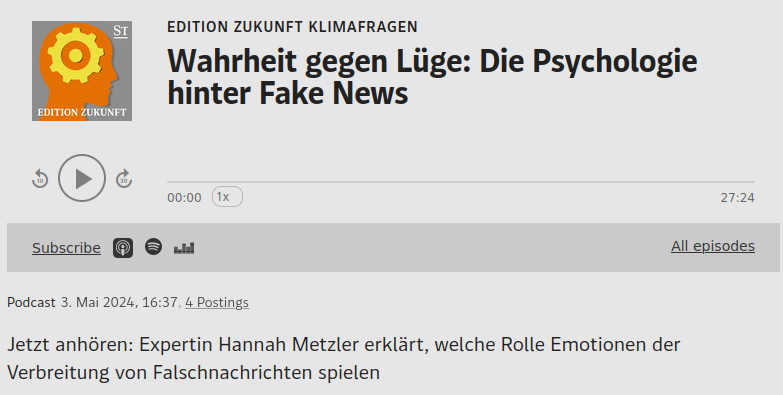
Five Myths about Misinformation
What I was wrong about when I wrote our grant proposal
Hannah Metzler
Complexity Science Hub & Medical University of Vienna
Vienna Behavioral Circle
May 16 2024


Myth 1: People are gullible
- People are easy to manipulate.
Solutions?
- Facts! Education!
- Make them more skeptical
The Science:
- It’s hard to change people’s mind.
- People are too skeptical.
- Alarmist narrative has negative effects.


Myth 2: Emotions = Irrationality
- Emotions make people fall for misinformation
Solutions?
- Make them less emotional
- Focus on accuracy
The Science:
- Emotions can indicate recognition
- Emotions are functional

Lühring*, Shetty*, Koschmieder, Waldherr, Garcia & Metzler (2023)
Myth 3: There’s a lot of misinformation
Solutions?
- Reduce it & warn people
The Science:
- Only 1-6% of all news.
- Most people don’t read the news.

Myth 4: Misinformation drives behavior
- Strong effects on opinions and behavior.
Solutions?
- Reduce it, facts, warning, inoculations etc.
The Science:
- Russian disinformation attacks during 2016 Trump election: no effects on attitudes, polarization & voting (study 1, 2)
- Even mass media have small effects at best



Myth 5: It’s social media’s fault!
- Algorithms radicalize people
- Echo chambers cause polarization
Solutions?


The Science:

So what?
- Reducing misinformation will not solve the real problems
- Alarmist narrative reduces trust in reliable news
- Misinformation & social media companies are scapegoats to avoid doing the hard work




Doing the hard work
- Improve democratic, medical & scientific institutions
- Trustworthy & transparent politics & media
- Address societal inequalities and conflicts
- Climate change, poverty, sexism, education, globalization, racism…





Thank you!
More on our project: https://hannahmetzler.eu/emomis
https://hannahmetzler.eu/misinfomyths

